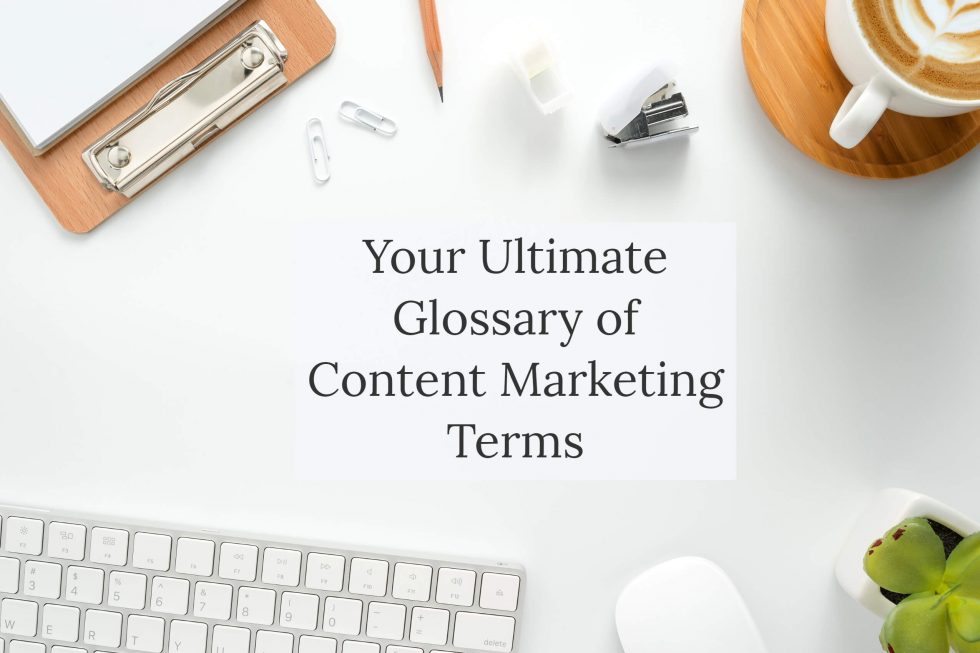
The Ultimate Content Marketing Glossary
Content marketing is defined as “the process of creating and sharing valuable free content to attract and convert prospects into customers, and customers into repeat buyers,” according to Copyblogger.
Sound simple? Some would say it is, while others would say it’s not. The truth is, content marketing can be as simple or complex as you make it.
If you’re curious about the world of content marketing, but don’t know where to start, a good place is with the terminology. Once you start speaking like a content marketer, it’ll be easier to start acting like one too!
Here’s a list of key content marketing terms.
Content Marketing Glossary
A / B testing
“An evidence-based evaluation method often used to compare two versions of a web page. For example, users might be sent to either the new or original version of a web page to determine which version people prefer.” (Content Champion)
Above the Fold
“Above the fold is the portion of a web page visible on the screen without scrolling.” (Copyblogger)
Affiliate Marketing
“A revenue model in which site A’s owners place ads on their site directing users to site B. Site A makes money when users click on the links and/or purchase the products. This is a common method of income generation for digital influencers.” (AMA)
Autoresponder
“Sends replies automatically when emails or texts are received.” (Content Champion)
Blogging
“Blogging is a core component of content marketing, driving site traffic, quality leads, and establishing your position as a thought leader in your industry. Your business blog should be built from a foundation of topics and keywords that you’ve discovered are important to your audience, and that help solve the challenges that your readers face. This means that promotional posts should be subtle and rare.” (HubSpot)
Boilerplate
“Standard reusable text often containing company details such as the company’s registration number that is commonly inserted into the footer of documents and web pages.” (Content Champion)
Branded Content
“Much like advertorials, this is content written by a brand in the style of editorial magazine or journalistic content. The content may or may not contain an overt sales push.” (AMA)
Buyer Persona
“Knowing your audience is vital to your success in content marketing — buyer personas help you do just that. They’re little snapshots of your target audience that allow you to create content that speaks to their specific needs.” (HubSpot)
Calls-to-Action
“Calls-to-action are a critical part of your content marketing, because they help convert all that site traffic you’re driving through content creation into actual contacts in your database. While not every piece of content you create requires a lead-gen call-to-action, your content should include some sort of CTA — whether to share your content on social, subscribe to your blog, or check out another page on your site.” (HubSpot)
Conversion funnel
“An idea representing the stages of a lead’s relationship with a company from potential prospect through to purchaser. Leads are channelled through a funnel using various marketing techniques, with the intention of producing a desired outcome, such as the purchase of a product or registration for a service.” (Content Champion)
Conversion rate
“A measure of how successful a web page or marketing activity is. For example, the number of website visitors that were converted into leads by completing a contact details form.” (Content Champion)
COPE
“An acronym for “Create Once, Publish Everywhere,” the cornerstone of content marketing. This can also sometimes be called “atomization.” For example, one might take an e-book and break it down into a white paper, several blog posts, an infographic and a video, publishing each to different users along the content funnel and on different channels.” (AMA)
Click Bait
“Catchy, often viral content that is used to capture clicks, but often has little to no journalistic value. Frequently, users who click in are disappointed by “this one surprising trick” or what you’ll “never believe” happened.” (AMA)
Content Strategy
“The process of planning for and managing content creation and distribution. Content strategy is the core of content marketing.” (AMA)
Copywriting
“The production of written content for marketing or advertising purposes. This is an essential skill for successful online content marketing.” (Content Champion)
Earned Media
“Sometimes called “free media”, this is publicity gained without paid-for advertising. For example, a piece of high quality content that is shared via word-of-mouth or social media.” (Content Champion)
E-books
“Ebooks are a common type of content that many marketers use — often to help generate leads. They are generally a more long-form content type than, say, blog posts, and go into in-depth detail on a subject.” (HubSpot)
Editorial Calendar
“An editorial calendar is just a fancy term for a publishing schedule. The editorial calendar helps content marketers and organizations plan and coordinate what content will be published, and when. This content can include blog posts, podcasts, email newsletters, and social media updates.” (Copyblogger)
Engagement
“The ability to hold the attention of an audience and persuade the audience to participate in some sort of activity. Engagement might mean getting Twitter followers to reshare your content, comment on a blog post, or answer a quiz on Facebook.” (Copyblogger)
Evergreen Content
“Content that remains of high value and quality over time, normally because it contains information that does not go out-of-date.” (Content Champion)
Funnel
“Sometimes called the “sales” or “conversion” funnel, this is an idea that represents the stages of a lead’s relationship with a company from prospect through to purchaser. The goal of most marketing is to attract new people to the funnel and then move them through it.” (Content Champion)
Ghostwriter
“A writer who does not receive credit for the content they produce. Sometimes no byline is attached the content (for example the general content found on most web pages) and sometimes the writing is credited to another person.” (Content Champion)
Impression
“In online advertising, an impression is counted when an ad is fetched from its source and seen by a user. Each impression is counted, whether or not the ad was clicked. Impressions are usually sold per thousand.” (Copyblogger)
Influencer
“Every industry has influencers — people that the rest of us look up to because of their experience and intelligence. Knowing who these influencers are helps content marketers stay on top of trends and learn more about their industry. If you happen to have a relationship with an industry influencer, you might consider broaching the subject of co-creating some content together — it could help you increase your own authority and reach in your industry.” (HubSpot)
Infographic
“A way of visually displaying complex information in a way that is easily understood, for example as a diagram.” (Content Champion)
Keyword
“A keyword — or keyword phrase — is what a search engine user inputs when looking for information. Keywords are important for content marketers because the keywords your target audience are typing into search engines are typically good topics to create content about.” (HubSpot)
Landing Page
“Landing pages are the epicenter of your lead generation. For the purposes of content marketing, they are where your lead-gen content assets live so you can convert more visitors into leads, and leads into customers.” (HubSpot)
Lead Generation
“The act of generating interest in a company to feed a sales pipeline. Lead generation is a deliberate act by a consumer that exchanges her contact information for a resource from the organization. This could be an email address in exchange for an exclusive report download.” (Copyblogger)
Market Segmentation
“To divide a market by a strategy directed at gaining a major portion of sales to a subgroup in a category, rather than a more limited share of purchases by all category users.” (Copyblogger)
Marketing Automation
“Tools and software that automate many marketing tasks for execution and measurement. Today’s content creators can now use these tools to directly measure the effectiveness of their content marketing campaigns, rather than simply going on “gut feel” or soft metrics like impressions.” (AMA)
Mentions
“Occurrences of the use of a company or brand name, for example in online conversations or articles. Many companies monitor their mentions, allowing them to respond, especially if they are mentioned in a negative context.” (Content Champion)
Omnichannel
“A rising marketing technique that puts the user in the center of many ongoing and separate yet related marketing efforts. For example, a store-goer may receive a text message alert when they are near a store, prompting a coupon or discount, receive a social media ad that they may still be interested in product X, and also receive added marketing via email and other channels.” (AMA)
On-page SEO
“SEO techniques that are applied to a web page, rather than externally (such as the creation of inbound links to the page). On-page SEO may include appropriate keywording in high-quality content and use of HTML page meta tags.” (Content Champion)
Owned Media
“This is media controlled by a brand. Includes a website, blog, and social media accounts. While owned media takes time to scale, in the long run it provides more control over communication, distribution, and cost.” (Copyblogger)
Page Views
“The number of times a page has been seen by visitors, or more specifically, the number of times a page has been requested from a server.” (Content Champion)
Podcast
“An audio file made available online and which is normally part of a series such as a radio show or an educational course. Podcasts can be downloaded and listened to later.” (Content Champion)
Retargeting
“Also known as remarketing, retargeting is a form of online advertising that keeps your brand front and center with bounced traffic. Retargeting works by dropping a cookie (a small, non-obtrusive piece of code that won’t slow down your site) into the web browser to identify that user as a previous visitor. When that visitor then browses the web, that cookie notifies the retargeting ad network when to load relevant ads about the company. This increases conversions as visitors are constantly kept in front of your product.” (Copyblogger)
ROI
“Short for ‘return on investment’. This is a quantitative measure of the profit generated vs the cost required to generate that profit.” (Content Champion)
Social Optimization
“You can optimize every piece of your content for sharing by adding social sharing icons, email-to-a-friend buttons, and lazy tweets. Make it ridiculously easy for your readers to share your content, because if you don’t provide the option, the chances of them doing the work for you are pretty slim.” (HubSpot)
Stories or Storytelling
“One of the most powerful content types. Humans have told stories for thousands of years. Building narrative and emotion into your content is an excellent way to engage and motivate readers.” (Content Champion)
Target Market
“A group of individuals who collectively make up the intended recipients of a marketer’s message or product. Products can have more than one specific target market. The process of dividing an audience into small, more relevant target markets is called ‘segmentation.’” (Copyblogger)
User-Generated Content
“Content contributed from individuals not paid or affiliated with a brand. Content created by users is often thought of as less biased than that created by brands, and can also help brands understand the real truth about how people use their products and services. Because UGC is not paid, it is also an economical way to build brand buzz.” (AMA)
Visitors
“People who visit your website.” (Copyblogger)




Add A Comment
You must be logged in to post a comment.